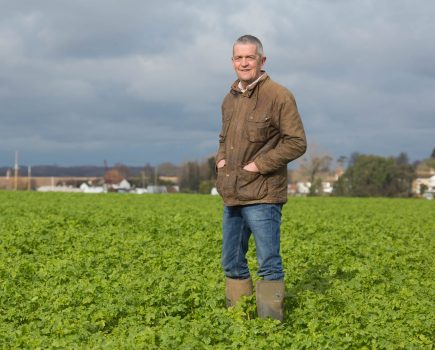There’s been many a bad experience with oilseed rape this season and as a result there’s a general expectation that the national crop is going to shrink in size fairly considerably this autumn. But, and there is a big but here, what are the chances of a repeat performance in the 2020 crop? Will cabbage stem flea beetle have the same impact as they did this year?
The truth of the matter is that no one really knows – as far as CSFB larvae are concerned, research is playing catch up. What is known is that the huge populations of larvae in crops this spring will increase the risk of another epidemic. But would a ‘proper’ winter help reduce larval numbers?
There’s little doubt that the unusually dry and warm autumn, followed by a mild winter hasn’t helped. Adult CSFB start laying their eggs in the autumn and this continues while temperatures are above 2°C, so last winter breeding activity was pretty much able to keep going right through to the spring without interruption.
The larvae don’t enter a diapause but live throughout the winter in leaf petioles and stems of OSR – active if temperatures are warm enough and inactive or in a quiescent state at low temperatures. They’re even able to withstand sub-zero temperatures during winter.
You’d hope a few good frosts may just inconvenience them a little. But while larval numbers have been reported to be less during a cold winter, very little had been established about the actual cold tolerance of larvae. Some Danish researchers set out to test this and their work, published in 2015 has shown that this may not be the case.
The study investigated the effect of exposure time, cold acclimatization, and larval stage on survival at temperatures of -5 and -10°C. Exposure time at -5 C was 1, 2, 4, 8, 12, 16, and 20 days and 6, 12, 24, 36, 48, 72, 96, 120, and 6 days at -10°C.
The results showed that larval mortality increased with increasing exposure time to cold, as may be expected, and was significantly lower for cold‐acclimatized larvae. But more crucially the results showed that to achieve a 50% mortality at -5°C, the larvae required 7.4 days of exposure. This rose to 9.6 days to achieve a higher larval mortality of 90%. Where the larvae were already acclimatized to the cold, the length of time required was longer at 11 and 15.1 days, respectively.

There’s a dark cloud hanging over the future of OSR – but should it all be doom and gloom?
At the lower temperature of -10°C, the time required was much less, with just 32.6 hours for 50% mortality and 66.8 hours for 90% rising to 70.5 and 132.2 hours, respectively, for acclimatized larvae.
Significant differences in mortality between larval stages were observed only at -5°C. When exposed to -5°C for eight days, the mortality of the first and second instars was 81.2 and 51.3%, respectively. When exposed to -10°C for 2 days, mortality of first and second instars was 70.5 and 76.1%.
Now Denmark is considerably cooler than the UK, but the researchers there concluded that spells of sufficient cold were seldom experienced for the number of days required to achieve high levels of larval mortality. So what that seems to mean is that there’s only a very slim chance that the UK will experience a sufficiently cold snap to kill off a significant number of larvae.
But putting that into context, in 2019 the flea beetle larvae had everything stacked in their favour – a dry autumn meaning many crops were off to a slow start then a warm winter. But is it time to fold your hand and give up on OSR? May be not.
Oilseed rape still has a lot to offer as a break crop and there are strategies that can help the crop overcome the larval burden. This is something we’ll be looking at in CPM next month. Growing the crop may require more thought and more attention to detail, but for those that dare try then I’m sure they’ll be rewarded.
Reference: Mathiasen, H, Bligaard, J and Esbjerg, P (2015), Survival of cabbage stem flea beetle larvae, Psylliodes chrysocephala, exposed to low temperatures. Entomol Exp Appl, 157: 220-226.
Based in Ludlow, Shrops, CPM technical editor Lucy de la Pasture has worked as an agronomist. @Lucy_delaP





